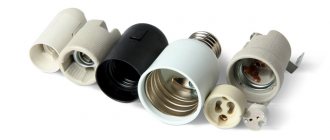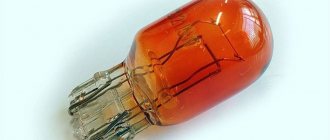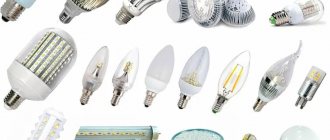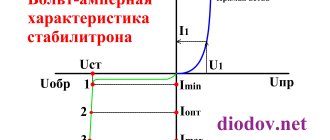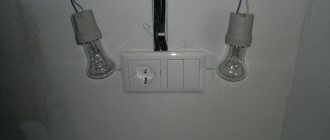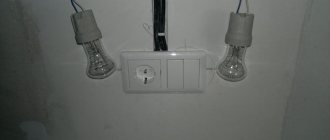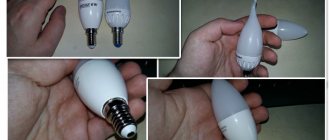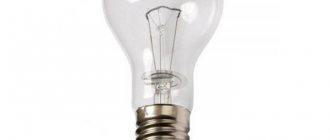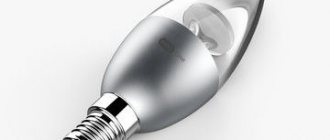- Classification of LED lamps by design and parameters
- What sockets are used in LED lamps
The range of LED lamps is extremely diverse and many types of LED lamps are unknown to most people. Therefore, buyers have many questions when it comes to choosing LED lamps to solve their problems. The questions asked concern the selection of models by shape, parameters, and control options. Of great interest is the possibility of replacing fluorescent and halogen lamps with ice-based analogues with the appropriate base.
In this article we will talk about the types of LED lamps that can be found on sale, as well as the main types of bases that allow you to install an ice lamp in a specialized lamp or a regular chandelier.
How is marking done?
The marking is a combination of a letter or several letters at the front and a number at the end.
The type is determined by the letter in front:
- E – threaded type base (sometimes the name Edison screw is also found);
- G – Pin base;
- R – Base, which has recessed contacts;
- B – Pin type base;
- S – Soffit base;
- P – focusing type base;
- T – Telephone socket;
- K – Cable socket;
- W – baseless lamp.
Also, after these letters, information about the subtype of lamp that is used may be indicated:
- U – Light bulb operating in energy-saving mode;
- V – Base, which has a conical end;
- A – Car lamp.
The letters are followed by numbers that indicate (in mm) the diameter of the base or the distance between its contacts. If after you see another letter, this is the number of contacts (s means 1, d – 2, t – 3, q – 4, p – 5).
Diffuser shape
The next important characteristic is the form of dissipation . There are only two main types:
- flat, having one main luminous surface;
- volumetric ones that shine around themselves, more like a flask in shape;
Accordingly, flat lamps provide only a spot of light underneath them, while volumetric lamps illuminate the space around them. Let's look at how light sources with different bases differ and where they are used most often :
Features and application of some types of lamp bases
Screw base E
The labeling of this group is quite simple. It includes the letter “E” and the designation of the body diameter. For better compatibility, you can often find special adapters that make the job much easier. The most popular sockets of this type are E10 , E14 , E27 , E40 . This subspecies is used for both incandescent and energy-saving and LED lamps. The most popular are the classic E27 and E14 . The largest type is used for lighting large areas - streets, parks, industrial buildings.
Installation of lighting fixtures with GX53 base
To prevent the PVC film around the body from melting and turning yellow, it is necessary to comply with the maximum power requirements, this is 5-7 W for LED lamps Source piramida-stroi.ru Let's
start with the fact that before installing a suspended, plasterboard, slatted or panel ceiling, you need to make wiring wires for each of the recessed lamps. They can be distributed into groups, or turned on all at the same time, but here we will not go into the intricacies of circuits for apartment or home electrical installations, but simply note that for each tablet a wire must be connected with a margin of 10-15 cm. This tail will help (create convenience) when connecting the device.
First of all, you need to drill holes in the suspended ceiling, which will coincide in size with the diameter of the mounting part of the cartridge and for this, as a rule, a core cutter is used. Each material requires its own type of crown, for example, for gypsum board and MDF it is better to use a toothed crown for plasterboard, but for PVC and slatted ceilings, a diamond-coated cutter is more suitable. In cases where the installation of spotlights is carried out on a PVC panel or suspended ceiling, thermal rings should be glued around the perimeter of the hole, since polyvinyl chloride may turn yellow with constant heating. This is not to say that the LED lamp will be hot, but it is still better to play it safe, especially since such gaskets will cost you mere pennies compared to lamps.
If the cartridge will be built into a plasterboard ceiling, then you need to fix the spring fastening only after painting the gypsum board Source youtube.com
The cartridge has a double copper wire for connection, and if the device is new, then its length is 100 mm, but that’s not the point - it needs to be powered from the wiring that you made before installing the finished suspended ceiling. Since lighting fixtures with a GX53 socket operate from ≈220 V, this means that all light bulbs or a separate group, which is powered through one switch key, should be connected in parallel. The most convenient way is to make a connection to an LED lamp from the network, and then stretch a double wire from this tablet to the next one, and so on until the very extreme point. You can connect the wires using blocks, but most often this is done by twisting and insulating with rag or vinyl tape or using sleeves for this.
Installation of lamps without a mortgage can be carried out with certain modifications to the product - this is done when the socket is attached directly to the concrete floor Source piramida-stroi.ru
If you need to attach the tablet directly to a concrete ceiling, then to do this you will have to make some simple alterations in the design of the cartridge. That is, the springs that unclench the fastening antennae must be removed along with these antennae and instead of them, a perforated ribbon suspension must be attached to the body, as shown in the top photo. Using this suspension, the lamp is fixed to the concrete floor with plastic dowels and screws (self-tapping screws).
Characteristics of popular types of lamp sockets
Base E14
Everyone's favorite popular "minion". Suitable for many types of light bulbs, used for both decorative and regular lighting. It is most often consumed under incandescent lamps, since the energy-saving option is more expensive. Also, do not forget about the LED variety , which does not have the disadvantages inherent in the lamps mentioned above. Due to their compactness, “minions” are widely used, because they can be inserted into almost any lamp or chandelier.
Base E27
The properties are the same as the above-mentioned E14, differing from it only in its more ancient history of origin and greater popularity. Regarding versatility, both designs are almost the same, because in case of emergency there are a countless number of special adapters.
Base G4
Designed for voltage from 12 to 24V, the estimated service life is up to two thousand hours. Designed for very miniature halogen light bulbs, which play an exclusively decorative role in lighting.
Base G5
Unlike its smaller subtype, it is also designed for LED lamps. They are often used in a suspended ceiling for local lighting of individual elements of the interior decor of a room.
Base G9
They are distinguished by their operation without transformers; they are used in a regular 220V network. They are installed in many lamps and chandeliers, the lamps are usually halogen (then the base part is made of glass), but there are also LED variations (in this case the glass is replaced with plastic). They occupy the second most popular place after the Edison screw.
Video description
How to choose GX53 spotlights.
Scope of use of lamps with GX53 base
Built-in spot LEDs, LED lamps or, as such lighting devices are most often called, tablets, are used for suspended ceilings of various types - stretch ceilings (vinyl, fabric), plasterboard, slatted and panel (PVC, MDF). The scope of use of lighting devices with such a base is quite wide, these include country houses and apartments, shops and shopping centers, restaurants, cafes and theaters, medical and educational institutions. We can say that such lighting is suitable in all cases where it is possible to install built-in spotlights.
Photos of spotlights on a suspended ceiling
It’s not that difficult to choose the right models yourself. But if in doubt, you can always contact a store consultant or designer. They will tell you which of the presented lamp options are best suited for a stretch ceiling, help you calculate the required quantity and recommend how to arrange them. Our selection of photographs will help you make a preliminary selection of the model and design you like.
Rarely seen holders
Some types of these integral elements of a lighting fixture are quite rare. These also include devices with recessed contacts.
Characteristics of rare types of base
With recessed contact . Belonging to this species is indicated by the presence of the symbol “R” in the marking. They are used in lamps of small dimensions and light weight.
Soffit "S" . There are options for placement on one side of the tubular lamp, or on both. Such sockets are appropriate in lamps used as mirror illumination, in bathrooms, as well as in car showrooms.
The base is soffit with contacts spaced on opposite sides of the lamp. Once upon a time they were used only for stage lighting, hence the name
Fixing "P" . In film projectors, lanterns, and searchlights, the “P” base is used - a fixing one. In terms of design, it resembles a soffit one. The difference is in the presence of an additional scattering platform.
The direction of the required light flux is determined by the prefabricated lens. The design is used for film projectors, spotlights, and flashlights.
Telephone "T" . This type is used in lamps used as backlighting, in remote controls, and in dashboards in cars.
T6.8 socket is used in KM (switch) light bulbs. The number after T indicates that the contact pins are located at a distance of 6.8 mm from each other
In the European Union, KM light bulbs with smaller sizes are used. They are marked according to the base 6 T4.5; T4.6; T5.5.
Glass and cable variations
Among the wide variety of LED lamps, there are also those that are called baseless. This element is there, but it is glass, like the lighting fixture itself.
Their use is narrow-profile. They are most often found in the automotive industry. When the symbol “W” appears at the beginning of the marking, it means it is a lamp with a glass base
On its basis there are current conclusions. Through them, the glass base comes into contact with the cartridge. The numbers present in the markings indicate the thickness of the glass part. They are followed by an “x” and the width of the base.
Cable sockets (K) are also not very common. Their area of application is projector lamps.
